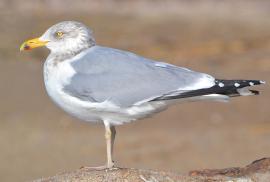Guide to Boreal Birds
Overview
This is the common "seagull" inland and along the coast. In recent decades it has become abundant, probably due to the amount of food available at garbage dumps, and has extended its range southward along the Atlantic Coast, often to the detriment of colonial birds such as terns and Laughing Gulls. Although a scavenger, it also eats large numbers of aquatic and marine animals and feeds on berries. It often drops clams and other shellfish on exposed rocks or parking lots in order to break the shells and get at the soft interior.
Description
23-26" (58-66 cm). Adult white with light gray back and wings; wing tip black with white spots; bill yellow with red spot on lower mandible; feet pink or flesh colored. First-year birds brownish. Acquires adult plumage in 4 years. See California Gull.
Voice
Loud rollicking call, kuk-kuk-kuk, yucca-yucca-yucca, and other raucous cries.
Nesting
2-4 heavily spotted, olive-brown eggs in a mass of seaweed or dead grass on the ground or a cliff; most often on islands. Nests in colonies.
Habitat
Lakes, rivers, estuaries, and beaches; common in all aquatic habitats.
Range/Migration
Breeds from Alaska east across northern Canada to Maritime Provinces, south to British Columbia, north-central Canada, and Great Lakes, and along Atlantic Coast to North Carolina. Winters in all but northernmost breeding areas; also along coasts, rivers, and lakes both in Southeast and in West from southern Alaska south to Baja California. Also in Eurasia.



